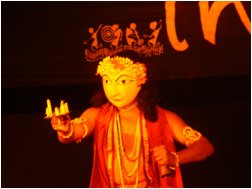 Arathi
Arathi
|
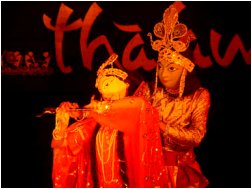 Radha
Krishna
Radha
Krishna
|
The performance
starts in a novel way, with a musical invocation identical to Siva-sthuthi,
with the flute and shehnai to the accompaniment of drums and harmonium.
Arati too is just praying with light that introduces Chhau as a unique
way of perceiving life. The exquisite Radha- Krishna, the eternal man and
woman, glide as if in a dream forgetful of life in their love and romance.
The fluid movements of the lovers make them part of the swaying Nature.
And Krishna giving his flute to Radha every now and then and music flowing
from her love is a different perception altogether. The masked dancers
seem like figurines stepped out of miniature paintings to dance and freeze
on the stage for momentary tableaux. An aura of mystery weaves a pattern
blended with the unheard of melody of fluting.
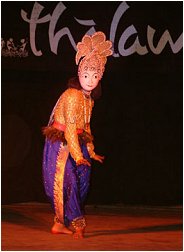 The Peacock
The Peacock
|
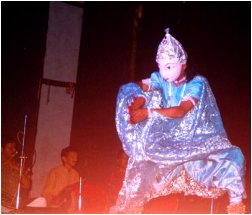 The lure of the Sea
The lure of the Sea
|
The Peacock, India's
own bird struts about in all her grace, beauty and vanity. The body seems
to be the house of movement and rhythm. A fictional body is created by
spontaneous energies in an original way. In an atmosphere of rain cast
sky, the joy of the bird is contagious. The rains. Yes, it rained gloriously
in our hearts!
"The Lure of
the Sea " is another unique theme. In soft light the liquid movements of
the dancer paints the enticing charms of the sea: the dancing waves that
embrace his heart, the bellowing waves that beckon his soul, its vastness
liberating his spirit from a sense of confinement, and its beauty with
ominous fascination. That he is lured to seek eternal rest in its depth,
that Lord Rama merged in the waters of the river Sarayu, that every drop
of water finally reaches the sea, is part of Indian philosophy.
"Rathri," is
a poetic presentation that depicts different aspects of Night: smoothening,
terrifying, tranquilizing in its sublime serenity. The onset of twilight
carrying light in its heart dims and disappears as darkness descends in
majestic strides. But its overwhelming gloom withdraws into a hazy shadow
as the moon showers its silver hues. The Night grows and fades with cinematographic
lyricism. Three dancers representing twilight, darkness and full- moon
create a wonderland of charm.
| "The
Hunter" and "The Fisherman" remind us of how life was so simple once upon
a time. And "Eklavya" retells the tale of self-made men from the marginalized
societies who rise to heroic dimensions.
With the last
piece we experience a leap into our own troubled times of violence. The
story of an innocent girl in love with life is driven to seek refuge in
death. Chandrabhaga, a young woman is playfully engrossed in the beauty
of the seashore near Konark temple, the domain of the Sun god. The Sun
god pursues her until she plunges into the sea, her only refuge.
Folk dances
like the Chhau loudly proclaim the rich cultural heritage of India and
the need to treasure our diversity. |
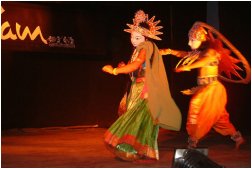 The sun god hunting the maiden Chandrabagha
The sun god hunting the maiden Chandrabagha
|
Chhau is a dance
drama much talked about among artists interested in the traditional theatre.
Pt. Gopal Prasad Dubey, the versatile master of Chhau dance is an internationally
known figure. He is also a choreographer working with mainstream cinema
as well as with experimental theatre. |
|

